- +353 (0)45 879 170
- info@caraghnurseries.ie
- Stickens, Caragh, Naas, Co. Kildare, Ireland
Totally tropical gardening
Like any other business, we are constantly striving to improve and adapt and when we added the new Palm House a year or so ago it was not necessarily to create a growing habitat for these tropicals it was more to have a space that they looked good, protected them for winds, not because they can’t take them but so that they didn’t blow over on the nursery as they are all in pots and lastly so that all the more exotic and tropical looking specimens and plants can be viewed in one place and how that has come together is amazing. We are able to offer the selection and more importantly the information of the types of palms and tropical plants we currently have available and the ones that fair well in Ireland and England. The other thing we wanted to show was how to team plants together to make a tropical looking garden, right here.
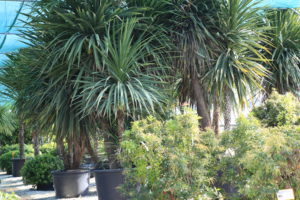
You can create your own little tropical oasis and here is how to go about it. It’s all about set-up and good selection, choosing tropical-look plants with bold colours and lush evergreen foliage. And there are a surprising number of these plants to do the job in our climate. When you get around to planting, do it densely. You might need to remove few plants later if things get too overgrown.
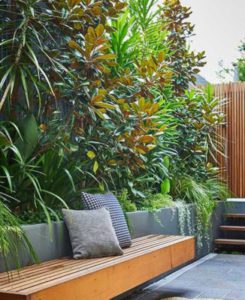
Aim for a backbone of large and glossy-leafed foliage plants and a variety of bold greens. Introduce vibrant flowering plants among the green. The key is texture with both plants and other materials, wooden screens or seating add a hammock or swing chair and you could be anywhere in the world. Anything with a large leaf creates the first backdrop and we like the look of these Magnolia Grandiflora, bamboo is a given for both texture, structure and also sound and then get going with the palms these are what are going to really give that tropical feel. Add a little colour with Cannas, Cordylines and even a Datura and you are away with a hack. Who needs the tropics with all the insects when you can create your own tropical garden.
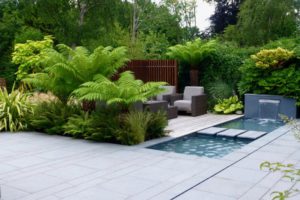
Aim to create a mix of deep shade corners, areas with filtered light and a few full-sun spots. Create meandering paths through your tropics . Dark-coloured pavers or stepping stones set into a light-coloured pebble path always look tropical.
Once you have pockets of microclimate, experiment with a few semi tropical plants. You’ll be surprised how many will grow. Site warmth-loving plants close to a south facing wall that retains heat. Grow a canopy of hardier plants to protect more tender ones below from frost. Maybe add a water feature, like a wide-rimmed water bowl, to fit the tropical picture.
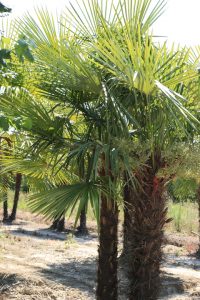
Here are some of the more tropical plants that we have in the Palm house, starting with the Trachycarpus Fortunei, it has proved to be an exceptionally hardy and tolerant palm. It will grow pretty well anywhere but to keep it looking in tip-top condition try to plant the Chusan palm in a moist but well-drained soil in good sun or part shade and, most importantly, out of the wind. When happy it will grow 30cm or more of trunk in a season. Branched heads of flowers are produced in early summer, adding to the exotic effect.
Ideal for creating a tropical looking garden space, the Mediterranean Fan Palm (Chamaerops Humilis) is quite hardy, particularly in the south and coastal areas, adding a lush exotic feel to any garden. The silvery-green leaves stay on the palm all year round giving great texture and structure. Best placed in full sun, away from harsh winds, it is a great addition to a Mediterranean-style garden, and can be grown in a container located in a bright, frost-free spot for the winter.
It will do well in any well-drained soil, grows quite slowly and needs little attention apart from cutting off any dead or damaged leaves. Eventually, it will form a well defined trunk.
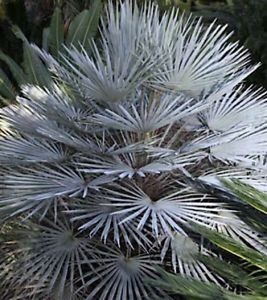
The Blue Mediterranean Fan Palm (Chamaerops Humilis Cerifera) is a stunning blue/grey coloured palm and a striking addition to your garden, It is almost as variable as the plain species in terms of colour, habit and size. They are similarly robust, taking, when established, any degree of drought or wind and are if anything, slightly more hardy to cold than their plain green cousins. They are perfect companion plants for the hardier succulents like the Yucca. Choose a position in full sun for best colour
Native to the Canary Islands, the Phoenix Canariensis grows in the wilds throughout the Islands but the largest can be found in La Gommera measuring as high as 66ft tall. Don’t worry this isn’t going to grow as big in your garden. During the autumn, creamy-yellow flowers will bloom from the palm, followed by reddish-yellow fruits. Commonly called the Canary Islands Palm or the Date Palm.
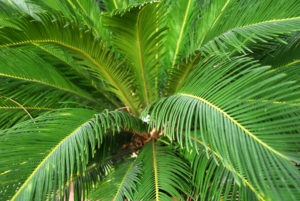
A real relic from the dinosaur age, Cycas Revoluta really does look like a lush prehistoric forest plant, but makes a wonderful textural and architectural plant that is easy to grow. Commonly called the Sago palm, it is a member of a very old type of plant called a Cycad. Not as frost hardy as some of the palms so will need protecting from harder frosts. It looks perhaps a little more like a fern, but the tough fronds are much more rigid. Very slow growing, it slowly forms a trunk over years.
The Yucca Rostrata or Beaked Yucca is a tall, attractive Yucca, bearing a crown of narrow, silver blue, sword-shaped leaves in contrast to a creamy white bark. Tall clusters of white flowers appear in summer, which may develop into fruit in milder regions. It is such a unique shaped Yucca – a real favourite around here! It’s perfect for growing in exotic planting schemes.
Younger specimens may be grown in a pot but is best planted in the ground as it gets that bit bigger as it can grown up to 3metres tall with time. Grow Yucca Rostrata in well-drained soil in full sun. Remove dead leaves for tidiness, but otherwise there’s no need to prune. Although hardy, it may need winter protection in sharper frosts.
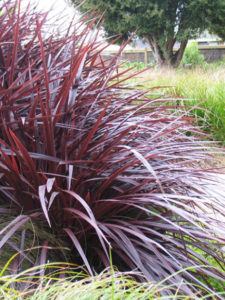
The Cordyline Australis is one of the easiest exotics to grow. It looks very like a palm, but actually it isn’t. Tall and single or multiple trunked, it has rosettes of long, sword shaped olive-green leaves. Its white flowers are beautifully fragrant. Salt and wind tolerant it is great for coastal positions. Cold hardy down to -8/9 degrees and evergreen, it gives great architectural interest to your garden throughout the whole year and great for growing in pots too although over time they can get big and although it is very slow growing we do have some larger specimens too.
Cordyline australis ‘Torbay Dazzler’ is a particularly lovely cabbage palm, bearing sword-shaped leaves with green and cream stripes. It’s perfect for growing in pots or as part of a mixed herbaceous border, particularly in tropical planting schemes it will grow into a small tree. Mature plants produce branches of sweet-smelling, ivory-white flowers in summer, which are extremely attractive to bees. Its autumn berries are a favourite for birds.
Cordyline Pink Champagne is a green-leaved Cordyline, despite the name, with narrow, upright leaves of pale green edged in white and blushed pink near the base — looking a bit sun splashed. A newer selection which does well in coastal locations as well as inland, reasonably drought resistant and tough. Not a large Cordyline, grows to approx 60-80cm.
Thats a lot of tropicalness (if that’s not a word, it should be) to be giving you in one go now I’m heading to the garden, maybe with a glass of something to complete the vibe, I was thinking more Pina colada than Lilt!
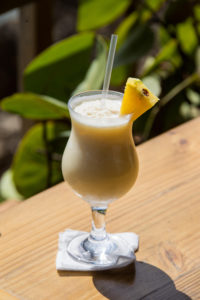

Quick Links
Information
Location
- Stickens, Caragh, Naas, Co. Kildare, Ireland
Copyright © 2025 CARAGH NURSERIES LTD | All Rights Reserved. eCommerce Web Design by 2Cubed | Privacy Policy | Cookie Policy
FREE DELIVERY
Our Gift to you
On all orders made online over €100
